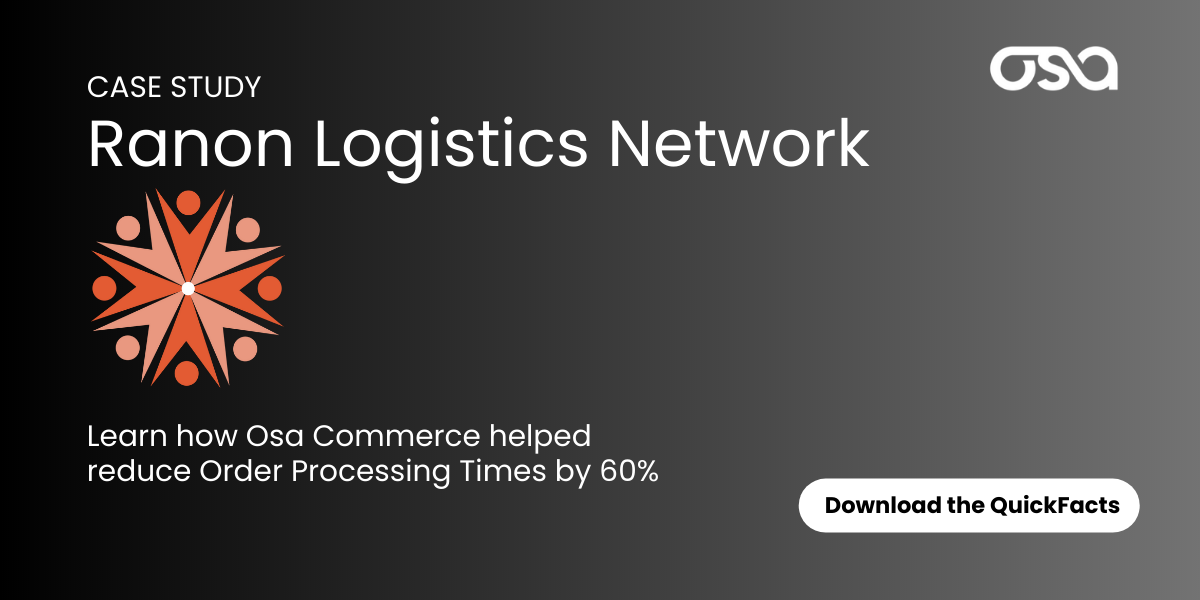%20(1024%20%C3%97%20512%20px)%20(2).png)
In the ever-evolving realm of e-commerce, staying ahead of the curve is not just a choice—it's a necessity. Enter Artificial Intelligence (AI), a revolutionary force that's transforming the way e-commerce operates, from enhancing customer experiences to optimizing supply chains. The marriage of AI and e-commerce is not merely a trend; it's a shift that empowers businesses to make smarter decisions, unlock new opportunities, and redefine the shopping landscape. In fact, the AI-enabled e-commerce solutions market is projected to be worth 16.8 Billion by 2030.
Today’s retailers and 3PLs must be prepared to level up their customers’ shopping experiences. Below, learn six ways AI can improve e-commerce and supply chain management.
1. Optimize Personalized Customer Experiences
Imagine walking into a physical store where every product, every shelf, and every interaction is tailored to your preferences. AI brings that personalized touch to e-commerce buying. By analyzing user behavior, purchase history, and even social media activity, AI-powered algorithms create personalized product recommendations that resonate with individual customers. This level of personalization not only increases the opportunity for conversions but also enhances customer loyalty and engagement.
In fact, 83% of consumers are willing to share data to produce a more personalized experience knowing full well that they are being shown ads directly targeted to their interests.
2. Employ Chatbots and Virtual Assistants
Recently, I had a delivery mishap regarding a skincare product I’d ordered online. I was able to straighten it out immediately by utilizing the retailer’s virtual assistant. I’m not alone; the era of long waiting times for customer support is fading away. AI-driven chatbots and virtual assistants are transforming customer interactions. These intelligent bots provide instant responses to customer queries, assist in product searches, and even guide users through the purchase process. As these systems learn from every interaction, the quality of assistance improves over time, providing customers with a seamless and efficient experience.
3. Invest in Robust Inventory and Demand Management
Maintaining optimal inventory levels is a delicate balance for e-commerce businesses. Too much tock ties up capital, while too little leads to missed opportunities. 3PLs and retailers who wish to further leverage AI-backed supply chain management offerings must invest in an inventory management tool that utilizes collaborative visibility—so all applicable parties are always in the loop.
AI offers predictive capabilities to analyze historical data, current trends, and even external factors to forecast demand accurately. This empowers businesses to optimize inventory levels, reduce carrying costs, and prevent stockouts, ensuring that customers find what they're looking for when they want it.

How Unified Commerce Actually Improves Inventory Turns

Scaling A 3PL Shouldn’t Require More People — It Requires Better Orchestration

E-commerce Complexity Is Killing Brands
4. Utilize Dynamic Pricing and Sales Optimization
AI enables dynamic pricing strategies that respond to real-time market conditions, competition, and customer behavior. Algorithms analyze various factors to adjust prices, maximizing revenue without sacrificing competitiveness. Additionally, AI optimizes sales opportunities for each consumer by identifying patterns and trends, allowing businesses to effectively tailor promotions and discounts. Businesses can also leverage AI dynamic optimization to target buyers based on their geographic location. Based on high stock counts in certain locations, retailers can target buyers in hopes of saving on shipping and logistics costs.
5. Leverage Visual Search and Product Discovery
AI isn't limited to text-based interactions. More than 36% of consumers have used visual search and over half say that visual information is more significant than text when they’re online shopping. Visual search technology uses AI to analyze images and find similar products. Shoppers can simply snap a picture or upload an image, and the AI-powered system presents relevant products from the catalog. This fosters a more intuitive and engaging shopping experience, driving conversions through visual discovery.
6. Prioritize Fraud Detection and Security
With the rise of online transactions, e-commerce faces increased security challenges. AI is able to use pattern recognition and anomaly detection capabilities to enable businesses to identify and prevent fraudulent activities in real-time. Whether it's unusual purchasing behavior or suspicious login attempts, AI safeguards sensitive customer data and ensures secure transactions. Consider investing in block-chain backed supply chain technology to further protect your shoppers’ information and your own company’s data.
The marriage of AI and e-commerce is not just a technological evolution; it's a strategic imperative. From revolutionizing customer experiences through personalization and chatbots to optimizing inventory management and pricing strategies, AI empowers e-commerce businesses to thrive in the digital age. As AI continues to advance, the potential for innovation within e-commerce becomes limitless, ushering in a new era of retail that's smarter, more efficient, and deeply connected to customer needs. To stay competitive, both 3PLs and retailers must act now to invest in AI-backed supply chain technology tools, in addition to other technologies . Embracing the power of AI is not just a choice; it's a transformative journey toward a future where e-commerce is redefined by intelligent insights.



 Flora Collins
Flora Collins
